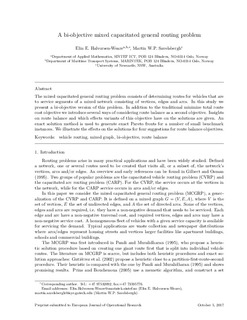The Bi-objective Mixed Capacitated General Routing Problem with Different Route Balance Criteria
Journal article, Peer reviewed
Submitted version

View/
Date
2016Metadata
Show full item recordCollections
- Publikasjoner fra CRIStin - SINTEF AS [5647]
- SINTEF Digital [2395]
- SINTEF Ocean [1384]
Original version
European Journal of Operational Research. 2016, 251 (2), 451-465. 10.1016/j.ejor.2015.11.024Abstract
In the mixed capacitated general routing problem, one seeks to determine a minimum cost set of vehicle routes serving segments of a mixed network consisting of nodes, edges, and arcs. We study a bi-objective variant of the problem, in which, in addition to seeking a set of routes of low cost, one simultaneously seeks a set of routes in which the work load is balanced. Due to the conflict between the objectives, finding a solution that simultaneously optimizes both objectives is usually impossible. Thus, we seek to generate many or all efficient, or Pareto-optimal, solutions, i.e., solutions in which it is impossible to improve the value of one objective without deterioration in the value of the other objective. Route balance can be modeled in different ways, and a computational study using small benchmark instances of the mixed capacitated general routing problem demonstrates that the choice of route balance modeling has a significant impact on the number and diversity of Pareto-optimal solutions. The results of the computational study suggest that modeling route balance in terms of the difference between the longest and shortest route in a solution is a robust choice that performs well across a variety of instances.
